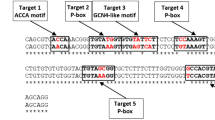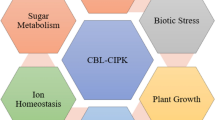Abstract
A salt tolerant alfalfaMedicago sativa L. cell line (HG2-N1) has been selected for growth in 171 mM NaCl. The salt tolerance characteristic is stable and is retained after growth in absence of salt selection for two months.In vitro translation was used to compare mRNA composition from the salt tolerant HG2-N1 and parent salt sensitive HG2 cell lines grown in the presence and absence of 171 mM NaCl. The results suggest that the mRNA composition differs between HG2-N1 and HG2 in a number of RNA species. The salt tolerant HG2-N1 shows both increases and decreases in specific polypeptides as compared to HG2. Many of the enhanced polypeptide bands from mRNA in the salt tolerant HG2-N1 variant appear to be constitutively expressed, since they can be detected from HG2-N1 cells grown in presence and absence of NaCl, but the expression of a few bands may depend on the presence of added NaCl. Most enhanced polypeptides, which are detected from mRNA in the salt tolerant variant HG2-N1 (grown on NaCl) are different from polypeptide bands enhanced in the salt sensitive HG2 line as a result of 24 hour salt stress. Similar results were obtained from two dimensional analysis ofin vivo labeled polypeptides. At least one isolated cDNA clone shows selective expression of mRNA in salt tolerant cells grown in NaCl. These results indicate that adaptive mechanisms for salt tolerance may differ in some aspects from acute stress mechanisms.
Similar content being viewed by others
References
Aviv H, Leder P (1973) Proc. Natl. Acad. Sci. USA 69:1408–1420
Chandler SF, Vasil IK (1984) Plant Sci. Lett. 37:157–164
Gulick P, Dvorak J (1987) Proc. Natl. Acad. Sci. USA 84:99–103
Hanson AD, Jacobsen JV, Zwar JA (1984) Plant Physiol. 75:573–581
King GJ, Hussey CE Jr, Turner VA (1986) Plant Mol. Biol. 7:441–450
Laemmli UK (1970) Nature 227:680–685
Maniatis T, Fritsch EF, Sambrook J (1982) Molecular Cloning: A Laboratory Manual. Cold Spring Harbor Lab. Press, N.Y.
Mayer JE, Hahne G, Palme K, Schell J (1987) Plant Cell Reports 6:77–81
McCoy TJ (1987) Plant Cell Reports 6:417–422
McCoy TJ, Bingham ET (1977) Plant Sci. Lett. 10:59–66
Ostrem JH, Olson SW, Schmitt JM, Bohnert HJ (1987) Plant Physiol. 84:1270–1275
Palmiter RD (1974) Biochemistry 13:3606–3615
Ramagopal S (1987) Proc. Natl. Acad. Sci. USA 84:94–98
Schenk RU, Hildebrandt AC (1972) Can. J. Bot. 50:199–204
Singh NK, Handa AK, Hasegawa PM, Bressan RA (1985) Plant Physiol. 79:126–137
Stavarek SJ, Rains DW (1984) In: Staples RC, Toenniessen GH (ed) Salinity Tolerance in Plants, NY pp 321–334
Thomas PS, (1980) Proc Natl Acad Sci USA 77:5201–5205
Waterborg JH, Pitter RL, Harrington RE (1989) Access (in press)
Author information
Authors and Affiliations
Additional information
Communicated by I.K. Vasil
Rights and permissions
About this article
Cite this article
Winicov, I., Waterborg, J.H., Harrington, R.E. et al. Messenger RNA induction in cellular salt tolerance of Alfalfa (Medicago sativa). Plant Cell Reports 8, 6–11 (1989). https://doi.org/10.1007/BF00735767
Received:
Revised:
Issue Date:
DOI: https://doi.org/10.1007/BF00735767




